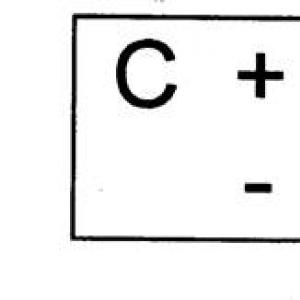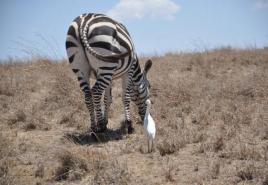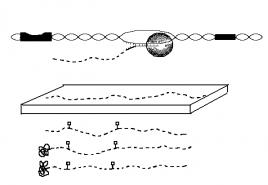Maturation (RNA processing). processing, splicing
This is the process of converting a transcript (pre-mRNA produced by transcription) into a mature mRNA suitable for translation. Processing stages:
1) Capping
A cap is added to the 5' end of the transcript, consisting of a modified guanine.
2) Polyadenization
From 100 to 200 adenine nucleotides are attached to the 3' end of the transcript.
3) Splicing
This is the process of cutting out the desired sections from the transcript and gluing them together. In eukaryotes, an average of 5/6 of the length is discarded from the transcript.
Mature mRNA consists of 5 regions:
1) Cap necessary for
- export of mRNA from the nucleus;
- preventing destruction of the 5'-end of mRNA as a result of the action of exonucleases;
- translation initiation.
2) 5"-NTO(untranslated area) encodes the broadcast frequency. Repressors or activators can attach to the 5'-UTR, changing the ability of this mRNA to bind to the ribosome.
3) Coding region- it is being broadcast. It starts with the start codon AUG and ends with one of the three stop codons.
4) 3"-NTO encodes the rate of destruction of this mRNA by nucleases. Repressors or activators can be attached to the 3'-UTR to change the rate of degradation.
5) Poly-A is also responsible for the lifetime of mRNA in the cytoplasm.
Processing- this is the stage of formation of functionally active RNA molecules from the initial transcripts. Processing is considered as post-transcriptional RNA modifications characteristic of eukaryotes. (In prokaryotes, the processes of transcription and translation of mRNA occur almost simultaneously. This type of RNA does not undergo processing in them.)
As a result of processing, primary RNA transcripts are converted into mature RNAs. Since there are several different types of RNA, each of them has its own modifications.
Processing of informational (matrix) RNA
In the DNA regions encoding the structure of the protein, a precursor of informational (matrix) RNA (pre-mRNA) is formed. The pre-mRNA copies the entire DNA nucleotide sequence from the promoter to the transcripton terminator. That is, it includes terminal untranslated regions (5" and 3"), introns and exons.
Pre-mRNA processing involves capping, polyadeneitherlamination, splicing, as well as some other processes (methylation, editing).
capping- this is the addition of 7-methyl-GTP (7-methylguanosine triphosphate) to the 5 "end of the RNA, as well as the methylation of the ribose of the first two nucleotides.
As a result, the so-called "cap" (cap) is formed. The function of the cap is related to the initiation of translation. Thanks to him, the initial site of mRNA is attached to the ribosome. The cap also protects the transcript from the destructive action of ribonucleases and perform a number of functions in splicing.
As a result polyadeneitherlyating a polyadenylic region (poly-A) about 100-200 nucleotides long (containing adenine) is attached to the 3 "end of the RNA. These reactions are provided by the enzyme poly-A polymerase. The signal for polyadenylation is the AAUAAACA sequence at the 3" end. At the -CA site, the mRNA molecule is cut.
Poly-A protects the RNA molecule from enzymatic degradation.
Capping and polyadenylation occur at the stage of transcription. The cap is formed immediately after the 5'-end of the synthesized RNA is released from RNA polymerase, and poly-A is formed immediately after transcription termination.
Splicing is the excision of introns and the connection of exons. Exons can connect in different ways. Thus, different mRNAs can be formed from one transcript. Splicing of messenger RNA involves small nuclear RNAs that have regions complementary to the ends of introns and bind to them. In addition to snRNA, various proteins are involved in splicing. All together (proteins and snRNA) form a nucleoprotein complex - spliceosome.
After processing, mRNA becomes shorter than its predecessor, sometimes by tens of times.
Processing of other types of RNA
During the processing of ribosomal and transfer RNA molecules, capping and polyadenylation do not occur. Modifications of these types of RNA occur not only in eukaryotes, but also in prokaryotes.
Three types of eukaryotic ribosomal RNA are formed as a result of cleavage of one transcript (45S-RNA).
Processing of a number of transfer RNAs may also involve cleavage of one transcript, while other tRNAs are obtained without cleavage. A feature of tRNA processing is that the RNA molecule goes through a long chain of nucleotide modifications: methylation, deamination, etc.
T ERMINATION
RNA polymerase will stop when it reaches the stop codons. With the help of a protein termination factor, the so-called ρ-factor (Greek ρ - "ro"), an enzyme and a synthesized RNA molecule are separated from the DNA matrix, which is primary transcript, a precursor of mRNA or tRNA or rRNA.
P ROCESSING RNA
Immediately after synthesis, the primary RNA transcripts, for various reasons, do not yet have activity, are "immature" and subsequently undergo a series of changes, which are called processing. In eukaryotes, all types of pre-RNA are processed; in prokaryotes, only rRNA and tRNA precursors are processed.
PROCESSING OF MRNA PRECURSOR
During transcription of DNA segments that carry information about proteins, heterogeneous nuclear RNAs are formed, which are much larger than mRNA. The fact is that, due to the mosaic structure of genes, these heterogeneous RNAs include informative (exons)
And uninformative ( introns) sections.
1. Splicing (English splice - stick together end-to-end) is a special process in which, with the participation of small nuclear RNAs, introns are removed and exons are preserved.

2. Capping (English cap - cap) - occurs even during transcription. The process consists in attaching the terminal nucleotide of the pre-mRNA to the 5'-carbon of N7-methyl-guanosine to the 5'-triphosphate.
The "cap" is necessary to protect the RNA molecule from exonucleases working from the 5' end, as well as to bind mRNA to the ribosome and to start translation.
3. Polyadenylation- with the help of polyadenylate polymerase using ATP molecules, from 100 to 200 adenyl nucleotides are attached to the 3 "end of RNA, forming a poly (A) tail. The poly (A) tail is necessary to protect the RNA molecule from exonucleases working with 3 "-end.
P ROCESSING OF RRNA PRECURSOR
rRNA precursors are larger molecules than mature rRNAs. Their maturation is reduced to the cutting of preribosomal RNA into smaller forms, which are already directly involved in the formation of the ribosome. Eukaryotes have 5S-, 5.8S-, 18S-, and 28S-rRNA. At the same time, 5S-rRNA is synthesized separately, and large preribosomal 45S-RNA is cleaved by specific nucleases with the formation
5,8S-rRNA, 18S-rRNA, and 28S-rRNA.
At prokaryotic ribosomal RNA molecules are completely different in their properties(5S-, 16S-
23S-rRNA), which is the basis for the invention and use of a number of antibiotics in medicine
P ROCESSING THE PRECURSOR T RNA
1. Formation at the 3" end of the C-C-A sequence. For this, some pre-tRNA from the 3' end extra nucleotides are removed until the triplet is "exposed" C-C-A, others are joining this sequence.
2. Formation of an anticodon loop occurs by splicing and removal of an intron in the middle part of the pre-tRNA.
3. Nucleotide modification in the molecule by deamination, methylation, reduction. For example, the formation of pseudouridine and dihydrouridine.
It is this stage that distinguishes the implementation of the available genetic information in such cells as eukaryotes and prokaryotes.
Interpretation of this concept
Translated from English, this term means "processing, processing." Processing is the process of formation of mature ribonucleic acid molecules from pre-RNA. In other words, this is a set of reactions that lead to the transformation of primary transcription products (pre-RNA of different types) into already functioning molecules.
As for the processing of p- and tRNA, it most often comes down to cutting off excess fragments from the ends of the molecules. If we talk about mRNA, then it can be noted that in eukaryotes this process proceeds in many stages.
So, after we have already learned that processing is the transformation of a primary transcript into a mature RNA molecule, it is worth moving on to considering its features.
The main features of the concept under consideration
These include the following:
- modification of both the ends of the molecule and RNA, in the course of which specific nucleotide sequences are attached to them, showing the place of the beginning (end) of translation;
- splicing - cutting off non-informative ribonucleic acid sequences that correspond to DNA introns.
As for prokaryotes, their mRNA is not subject to processing. It has the ability to work immediately after the completion of the synthesis.
Where does the process in question take place?
In any organism, RNA processing takes place in the nucleus. It is carried out by means of special enzymes (their group) for each individual type of molecule. Translation products such as polypeptides that are directly read from mRNA can also be processed. The so-called precursor molecules of most proteins - collagen, immunoglobulins, digestive enzymes, some hormones - undergo these changes, after which their real functioning in the body begins.
We have already learned that processing is the process of forming mature RNAs from pre-RNAs. Now it is worth delving into the nature of ribonucleic acid itself.
RNA: chemical nature
It is a copolymer of pyrimidine and purine ribonucleitides, which are connected to each other, in the same way as in DNA, by 3' - 5'-phosphodiester bridges.

Despite the fact that these 2 types of molecules are similar, they differ in several ways.
Differences between RNA and DNA
Firstly, ribonucleic acid has a carbon residue, which is adjacent to pyrimidine and purine bases, phosphate groups - ribose, while DNA has 2'-deoxyribose.
Secondly, the pyrimidine components also differ. Similar components are the nucleotides of adenine, cytosine, guanine. RNA contains uracil instead of thymine.

Thirdly, RNA has a 1-stranded structure, while DNA is a 2-stranded molecule. But in the ribonucleic acid chain there are regions with opposite polarity (complementary sequence), due to which its single chain is able to fold and form "hairpins" - structures endowed with 2-helix characteristics (as shown in the figure above).
Fourthly, in view of the fact that RNA is a single strand, which is complementary only to the 1st of the DNA strands, guanine does not have to be present in it in the same content as cytosine, and adenine - like uracil.
Fifth, RNA can be hydrolyzed with alkali to 2', 3'-cyclic diesters of mononucleotides. The role of an intermediate product in hydrolysis is played by 2', 3', 5-triester, which is incapable of formation in the course of a similar process for DNA due to the absence of 2'-hydroxyl groups in it. Compared to DNA, the alkaline lability of ribonucleic acid is a useful property for both diagnostic and analytical purposes.

This sequence is complementary to the gene chain (coding) from which the RNA is “read”. Because of this property, a ribonucleic acid molecule can specifically bind to a coding strand, but is unable to do so with a non-coding DNA strand. The RNA sequence, except for the replacement of T with U, is similar to that of the non-coding strand of the gene.
RNA types
Almost all of them are involved in such a process as the following types of RNA are known:
- Matrix (mRNA). These are cytoplasmic ribonucleic acid molecules that act as templates for protein synthesis.
- Ribosomal (rRNA). This is a cytoplasmic RNA molecule that acts as structural components such as ribosomes (an organelle involved in protein synthesis).
- Transport (tRNA). These are molecules that take part in the translation (translation) of mRNA information into a sequence of amino acids already in proteins.
A significant part of RNA in the form of 1st transcripts, which are formed in mammalian cells, is subject to degradation in the nucleus and does not play an informational or structural role in the cytoplasm.
In human cells (cultivated), a class of small nuclear ribonucleic acids was found that are not directly involved in protein synthesis, but affect RNA processing, as well as the overall cellular "architecture". Their sizes vary, they contain 90 - 300 nucleotides.
Ribonucleic acid is the main genetic material in a number of plant and animal viruses. Some RNA viruses never go through the same RNA-to-DNA stage. But still, many animal viruses, for example, retroviruses, are characterized by reverse translation of their RNA genome, directed by RNA-dependent reverse transcriptase (DNA polymerase) with the formation of a 2-stranded DNA copy. In most cases, the emerging 2-stranded DNA transcript is introduced into the genome, further providing the expression of viral genes and the production of the latest copies of RNA genomes (also viral).
Post-transcriptional modifications of ribonucleic acid
Its molecules synthesized with RNA polymerases are always functionally inactive and act as precursors, namely pre-RNA. They are transformed into already mature molecules only after they have passed the corresponding post-transcriptional modifications of RNA - the stages of its maturation.
The formation of mature mRNA begins during the synthesis of RNA and polymerase II at the elongation stage. Already to the 5'-end of the gradually growing RNA strand is attached by the 5'-end of GTP, then the orthophosphate is cleaved off. Further, guanine is methylated with the appearance of 7-methyl-GTP. Such a special group, which is part of the mRNA, is called a "cap" (hat or cap).
Depending on the type of RNA (ribosomal, transport, template, etc.), precursors undergo various sequential modifications. For example, mRNA precursors undergo splicing, methylation, capping, polyadenylation, and sometimes editing.

Eukaryotes: general characteristics
The eukaryotic cell is the domain of living organisms, and it contains the nucleus. In addition to bacteria, archaea, any organisms are nuclear. Plants, fungi, animals, including the group of organisms called protists, are all eukaryotic organisms. They are both 1-celled and multicellular, but they all have a common plan of the cellular structure. It is generally accepted that these so dissimilar organisms have the same origin, which is why the nuclear group is perceived as a monophyletic taxon of the highest rank.
Based on popular hypotheses, eukaryotes arose 1.5 - 2 billion years ago. An important role in their evolution is given to symbiogenesis - the symbiosis of a eukaryotic cell that had a nucleus capable of phagocytosis and bacteria swallowed by it - the precursors of plastids and mitochondria.
Prokaryotes: general characteristics
These are 1-celled living organisms that do not have a nucleus (formed), the rest of the membrane organelles (internal). The only large circular 2-stranded DNA molecule that contains the bulk of the cellular genetic material is one that does not form a complex with histone proteins.
Prokaryotes include archaea and bacteria, including cyanobacteria. Descendants of non-nuclear cells - eukaryotic organelles - plastids, mitochondria. They are subdivided into 2 taxa within the domain rank: Archaea and Bacteria.
These cells do not have a nuclear envelope; DNA packaging occurs without the involvement of histones. The type of their nutrition is osmotrophic, and the genetic material is represented by one that is closed in a ring, and there is only 1 replicon. Prokaryotes have organelles that have a membrane structure.
The difference between eukaryotes and prokaryotes
The fundamental feature of eukaryotic cells is associated with the presence of a genetic apparatus in them, which is located in the nucleus, where it is protected by a membrane. Their DNA is linear, associated with histone proteins, other chromosomal proteins that are absent in bacteria. As a rule, they contain 2 nuclear phases. One has a haploid set of chromosomes, and subsequently merging, 2 haploid cells form a diploid cell, which already contains the 2nd set of chromosomes. It also happens that during subsequent division, the cell again becomes haploid. This kind of life cycle, as well as diploidy in general, is not characteristic of prokaryotes.
The most interesting difference is the presence of special organelles in eukaryotes, which have their own genetic apparatus and reproduce by division. These structures are surrounded by a membrane. These organelles are plastids and mitochondria. In terms of vital activity and structure, they are surprisingly similar to bacteria. This circumstance prompted scientists to think that they are the descendants of bacterial organisms that entered into symbiosis with eukaryotes.
Prokaryotes have few organelles, none of which are surrounded by a 2nd membrane. They lack the endoplasmic reticulum and lysosomes.
Another important difference between eukaryotes and prokaryotes is the presence of the phenomenon of endocytosis in eukaryotes, including phagocytosis in most groups. The latter is the ability to capture by means of confinement in a membrane bubble, and then digest various solid particles. This process provides the most important protective function in the body. The occurrence of phagocytosis is presumably due to the fact that their cells are of medium size. Prokaryotic organisms, on the other hand, are incommensurably smaller, which is why in the course of eukaryotic evolution, a need arose associated with supplying the cell with a significant amount of food. As a result, the first mobile predators arose among them.

Processing as one of the stages of protein biosynthesis
This is the second step that starts after transcription. Protein processing occurs only in eukaryotes. This is mRNA maturation. To be precise, this is the removal of regions that do not code for a protein, and the addition of controls.

Conclusion
This article describes what processing is (biology). It also tells what RNA is, lists its types and post-transcriptional modifications. The distinctive features of eukaryotes and prokaryotes are considered.
Finally, it is worth recalling that processing is the process of formation of mature RNA from pre-RNA.
Capping and polyadenylation of mRNA is called processing ( post-transcriptional modification).
Capping:
A residue is attached to the 5" end of all eukaryotic mRNAs during processing. 7-methylguanosine with education unique 5"à 5" phosphodiester bond. This extra nucleotide is called cap or cap.
Cap functions :
1. it protects RNA from exonucleases
2. helps the binding of the mRNA molecule to the ribosome.
Polyadenylation:
The 3" end is also modified immediately after transcription is completed. Special enzyme - polyadenylate polymerase attaches from 20 to 250 adenylic acid residues (poly (A)) to the 3 "end of each RNA transcript. Polyadenylate polymerase recognizes a specific sequence aaaaa, cleaves a small fragment of 11-30 nucleotides from the primary transcript and then adds a poly(A) sequence. It is generally accepted that such a "tail" facilitates the subsequent processing of RNA and the export of mature mRNA molecules from the nucleus.

As mRNA participates in translation processes, the length of the polyA fragment decreases. 30 adenyl nucleotides are considered critical for stability.
The entire set of nuclear transcripts of RNA polymerase II is known as heterogeneous nuclear RNA(hnRNA).
All 3 classes of RNA are transcribed from genes that contain introns(non-informative sections) and exons(sections of DNA that carry information). The sequences encoded by DNA introns must be removed from the primary transcript before the RNA becomes biologically active. The process of removing copies of intron sequences is called RNA splicing.

RNA splicing is catalyzed complexes of proteins with RNA, known as "small nuclear ribonucleoprotein particles"(snRNP, English small nuclear ribonucleic particles, snRNP). Such catalytic RNAs are called ribozymes.
Functions of introns:
protect the functionally active part of the cell genome from the damaging effects of chemical or physical (radiation) factors
allows using the so-called alternative splicing increase the genetic diversity of the genome without increasing the number of genes.

Alternative splicing:
As a result of a change in the distribution of exons of one transcript during splicing, different RNAs and, consequently, different proteins arise.
More than 40 genes are already known, the transcripts of which are subjected to alternative splicing. For example, a transcript of the calcitonin gene, as a result of alternative splicing, produces RNA that serves as a template for the synthesis of calcitonin (in the thyroid gland) or a specific protein responsible for taste perception (in the brain). The transcript of the -tropomyosin gene undergoes even more complex alternative splicing. At least 8 different tropomyosin mRNAs derived from a single transcript have been identified (see figure)

33 . The general scheme of protein biosynthesis - necessary prerequisites:
Information flow - information transfer scheme (the central dogma of molecular biology). DNA replication and transcription - enzymes, mechanism. Reverse transcription, the role of revertases. mRNA processing and splicing. Characteristics of the genetic code, codon, anticodon.
The difference between protein biosynthesis and the biosynthesis of other molecules:
There is no correspondence between the number of matrix monomers and in the reaction product (4 nucleotides - 20 amino acids)
There is no complementarity between the mRNA (template) and the peptide chain of the protein (product).
The general scheme of protein biosynthesis - necessary prerequisites:
· information flow(transfer of information from DNA to RNA to protein)
· plastic flow(amino acids, mRNA, tRNA, enzymes)
· energy flow(macroergy ATP, GTP, UTP, CTP)







